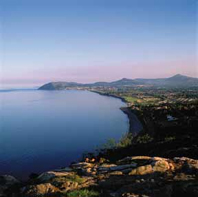
|
Dublin-sur-Mer
You have to be an optimist to be in the tourist trade, they say, particularly with today's tense international climate. And sure enough, beautiful Ireland, just like belle France, is eagerly looking forward to a fine summer season. Business was up slightly in 2003, but staying competitive is tough. No one can afford to be complacent, even with Ireland's many natural attractions.
"Worth seeing, yes, but not worth going to see", is how Samuel Johnston in 1791 summed up the Giant's Causeway, that splendid basilica of basalt formed like organ pipes on the rocky Antrim coast. Could his words be taken as a warning today that the future growth of Irish tourism may not lie in beautiful landscapes at all?
Ireland is not as dependent on tourism as it once was, though revenue from visitors still came to a hefty 4 billion euros in 2002, nearly three times the 1990 level. This is quite a success story.
However, recent business has been sluggish. Visits to Ireland rose by just 1% to 5.9 million, and this thanks to visitors from Europe (including Britain). In fact, overall tourist numbers are still well down on 2000. And the main reason is the Americans, or rather, lack of them.
As with Paris where hoteliers anguish over the absence of their meilleurs ennemis, US visitors drive Irish tourism. At some 900,000 visitors, they remain the biggest group, after Britons (3.5 million). The trouble is, 20% fewer North Americans visit the emerald isle now than in 2000. Most blame global insecurity and the weaker dollar.
Can the French "save" the Irish summer season? It is more likely to happen that way than the other way around. Mind you, Irish tourist spending in France has been soaring too, from just 40 million euros in 1995 to an admirable 190 million in 2003. But this is a piddling drop for the world's top tourism destination where 77 million visitors spent 35 billion euros in 2002.
France, meanwhile, has overtaken Germany as Ireland's second source of visitors from Europe, sending some 320,000 last year. French tourists to Ireland will no doubt return in force this summer, seeking out bargains and avoiding the risk of another deadly heatwave back home. But who will benefit? French tourists have always prefered fishing, hunting and trekking in areas like Connemara and around the Shannon, to lazing as we do on our very "sub-tropical" beaches. Traders in these traditional areas heavily rely on a good summer crop, but in recent years, they have had a new challenger to worry about: Dublin.
The dear old dirty capital was relatively shunned by tourists be-fore, and used literally to "pale" as a place to go when compared with Paris or even similar-sized Copenhagen or Amsterdam. But the 1990s were Dublin's decade, with Ireland's city-on-sea deservedly emerging as one of the most popular short break destinations in Europe. Social buzz and cultural energy, rather than postcard scenery, are the trade marks of Dublin-sur-Mer, though the Georgian squares, Trinity and the Vico Road add class to the cocktail -- not to mention the afternoon escapades to the wilds of Sally Gap or the dunes of Brittas Bay.
The point is, while we all love wild ponies and soggy, boggy lakes, and while some of the bay views along the squiggly road from Glengarrif to Kenmare will stay with you forever, without Dublin, the Irish tourist industry might not be in such good shape.
Take these startling numbers. In 1990 Dublin accounted for just 22% of Ireland's tourist revenue, compared with 18% in the South West (mainly Kerry and Cork), 17% in the West (Connemara, etc), and 11% in the North-West (Donegal), with the rest spread between the Shannon, the South East and the Midlands. Makes sense.
But by 2002, Dublin's share surged to 30%. The shares of most of the other regions were flat, with only the South-West rising, albeit by a meagre percentage point. Worse, the West's share fell, to 14%!
Despite my deep affection for Connemara, as a hibernophone Dubliner living in the heart of Paris, this restoration of the city's greatness strikes me as being proper order. But to many others, given Dublin's history, this is just more market pillaging by the capital: not so much a Celtic Tiger at work as a Viking one!
It's certainly a further blow to the myth about Ireland's rural appeal. And it challenges the cultural branding of Ireland. The onus is on the West to fight back. And no doubt it will, though the impetus for a revival there, while leaning on the outrageously beautiful countryside, may well come from the vibrant city of Galway.
The Irish tourist market is maturing, becoming more urban. If Samuel Johnston were still around today, perhaps he would reverse his dictum: that compared with some European rivals, Irish cities are not worth seeing, but certainly worth going to see.
©RJ Doyle May 2004
blog comments powered by Disqus